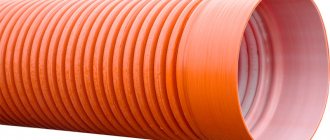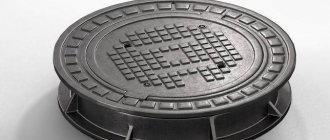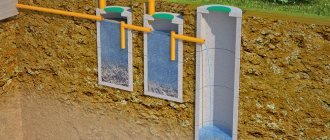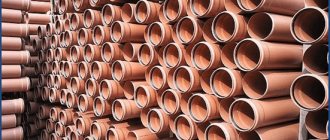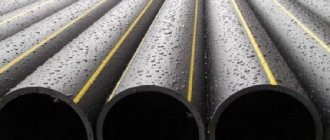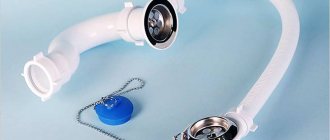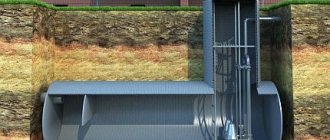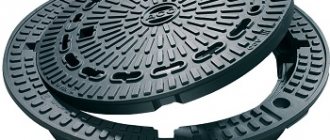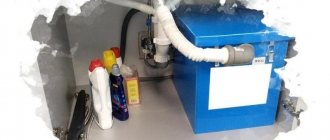When installing any pipeline system, there is always a need to change its direction - this happens with the help of parts built into the pipeline, called bends. In domestic systems for the removal of gray and fecal waters, such an element for changing the direction of the line is a sewer outlet, made of various materials and having several standard sizes.
When independently installing a sewer line at home, plastic types of pipelines are mainly used, while the sewer outlets inside and outside buildings have some differences. Knowledge of their technical characteristics will help to carry out the correct installation of external and internal sewer lines in compliance with technology without unnecessary financial costs.
Rice. 1 What types of sewer pipes are there?
What are the types of shaped elements for sewerage?
When choosing pipes and fittings for sewerage, the construction market offers a wide range of products that can be divided into several categories. Depending on the location of the highway, there are:
- Elements for installation of internal sewerage. They are installed inside residential premises and serve to drain wastewater from toilets, bathtubs, sinks, washing machines and dishwashers. Products in this category are painted gray.
- Parts for external sewerage. Elements, designed according to their physical parameters to operate in harsh environmental conditions, serve to drain wastewater from residential premises into the general sewer system or settling tanks. To make it easier to detect their location underground, they are painted orange.
Rice. 2 Cast iron pipes and fittings
Based on the material used for individual use, the following elements are distinguished:
Cast iron. Obsolete products that currently have no practical use in the household. Cast iron sewer pipes are heavy, difficult to install due to the lack of built-in sealing rings, and have an internal rough surface that becomes covered with growths over time. Although pipes have a long service life of about 70 years when used inside buildings, in the ground they rust and deteriorate much faster. Therefore, when laying, their external waterproofing is required.
Steel. A virtually unused type of sewer pipe in everyday life due to its low corrosion resistance, complex installation involving welding and thin walls. In industry and public utilities, galvanized steel is used to increase corrosion resistance.
Fig.3 Installation of sewerage system outlets
Asbestos cement. A good choice of option for sewer pipes compared to the two previous versions; you can use pressure and non-pressure types. Unlike cast iron, asbestos-cement products are lighter, do not corrode, have smooth internal walls and a long service life. The tightness of the connection is achieved through the use of rubber sealing rings of the CAM system; the disadvantages include fragility and the lack of bends for turning the line (half bends made of metal are used).
Ceramics. Ceramic piping is easy to install thanks to built-in rubber rings and swivel fittings, has smooth glazed internal walls, long service life and the best resistance to aggressive chemicals. The disadvantages of ceramics include the very high cost.
Rice. 4 Characteristics of polypropylene (PP)
Plastic. The absolute leader among all types of sewer pipelines in everyday life, which are made from the following plastic materials:
Polyethylene (HDPE). The scope of application of polyethylene pipelines does not affect individual sewerage systems; they are used in industry and public utilities.
When installing such lines, pipes are connected end-to-end by welding or using external couplings welded on top and sealing the butt joint. Polyethylene is black in color and resistant to corrosion and aggressive chemicals.
Parameters, dimensions, weight
For the installation of a sewer collector, you can purchase bends of any diameter. The table shows common parameters of shaped elements.
| Diameter (mm) | Length (mm) | Weight (kg) depending on material of manufacture |
| 15 | 28 | 0,04 |
| 20 | 29 | 0,06 |
| 25 | 38 | 0,11 |
| 32 | 48 | 0,19 |
| 40 | 57-60 | 0,26-0,5 |
| 50 | 75 | 0,5-1 |
| 65 | 100 | 1-1,7 |
| 80 | 120 | 1,4-2,8 |
| 100 | 150 | 2,2-5 |
| 125 | 190 | 3,8-6,2 |
| 150 | 225 | 6,1-13,3 |
| 200 | 300 | 14,9-39 |
| 250 | 375 | 23-46,7 |
Polypropylene bends for sewerage
Sewage outlets made of gray polypropylene are used only indoors; for outer diameters of sewer pipes of 110 mm, products with rotation angles of 15, 30, 45, 67, 87 degrees are used. Products made of polypropylene plastic have the following main characteristics:
- Polypropylene is afraid of ultraviolet radiation, so it is used only indoors.
- Neutrality towards acid, alkaline and alcohol solutions and inorganic compounds.
- The melting point of the material is about 170 C., during operation, the permissible temperature of the working fluid should not exceed 95 C.
- The brittleness temperature of the material ranges from -20 to -25 C.
As can be seen from the given characteristics, polypropylene is destroyed at insufficiently low temperatures, therefore the pipe and polypropylene sewer outlet are not used in external pipelines.
Rice. 7 Sewer outlet - types and sizes
PVC sewer bends
Sewer lines made of unplasticized polyvinyl chloride are widely used outside and inside buildings; a 110 mm sewer outlet has standard deviation angles from the central center line of 15, 30, 45, 67, 87 degrees. The PVC sewer line has the following features:
- The elements are designed to operate with liquids whose temperature does not exceed 45 C and does not fall below 60 C.
- The pipes are lightweight and have a smooth internal surface, providing high throughput.
- The products are not subject to corrosion, resistant to acid and alkali, and neutral to most chemicals.
- The material has low thermal conductivity, comparable to thermal insulators - this reduces the risk of line freezing in winter.
- Due to the chemical resistance of the material to various substances, the service life of PVC sewers reaches 50 years.
Bends for corrugated pipes Korsis
Korsis corrugated pipes are products made using the latest technologies; the design features a two-layer structure with smooth internal walls and a black outer corrugation that protects the surface from ultraviolet radiation. Thanks to this structure, the pipes have high ring rigidity, allowing them to be used at great depths. The material of the pipe inner walls is polypropylene - this allows the products to be used at temperatures of flowing liquids of about 65 C.
Rice. 8 Korsis pipes, socket with O-ring - design and appearance
Dimensions of sewer fittings and recommendations for installation of sewer lines
The dimensions of sewer outlets correspond to the pipes to which they are connected and are regulated by GOST. It should be taken into account that for external sewerage, special orange-colored pipes are used, which are thicker than internal pipes (2 mm wall thickness of internal pipes and 3.1 - 3.4 mm of external pipes).
Rice. 9 Plastic sewer outlet - dimensional parameters
When laying an external sewer line, the following recommendations must be observed:
- The trench is dug in such a way as to prevent pipes from freezing in winter, while taking into account the slope, which is for a line with a diameter of 110 mm. is 20 mm. per 1 linear meter.
- If the depth is too large, the pipes are thermally insulated (you can use a built-in or external heating electric cable) and raised higher.
- A layer of sand 100-150 mm thick is usually placed at the bottom of the trench; for thermal insulation and reducing the load on the pipe walls, the pit is filled with expanded clay and then leveled to the ground with soil.
Determination of nominal diameter
Regardless of the material from which sewer pipes are made and the scope of their purpose, they have the current standard dimensions:
- D – outer diameter;
- d – diameter from the inside;
- S – wall thickness;
- Dy – conditional pass.
The internal diameter sign is placed on the marking of cast iron products, while the external dimensions are most often indicated on plastic products. The external width of the product for all categories remains unchanged, only the wall thickness changes. For example, if a pipe has D = 33.5 mm, then S can vary within 2.8-4 mm. The level of strength of the product and resistance to internal and external pressure depend on the thickness of the walls. Fluid dynamics engineers, for all internal diameters, use one approximate figure of 25 mm and call it the nominal bore.
Conditional diameter is the maximum throughput of the pipeline. The efficiency and performance of the structure directly depends on its size. If you know the dimensions of the internal lumen, you can choose the right connecting elements so that the sewage system has a holistic appearance without the threat of depressurization.
All products of domestic and foreign production have a nominal diameter that is most suitable to the nearest standard according to GOST 28338-89 and GOST 3262-75.
Determination of nominal diameter
In addition to the sewerage capacity, it is also necessary to calculate its angle of inclination. These parameters directly depend on the size of the product and the material it is made of. Formula for calculating the angle of inclination: V× (H / D)½ ≥ K. Where:
V is the speed of movement of the waste; H is the degree of filling; D is the outer diameter; K is the roughness value of the internal walls, for polymers = 0.5.
Pipe diameter with slope
The greater the slope, the higher the waste flow rate. The sewage system is less clogged and is able to serve a larger number of premises.
Compliance with generally accepted rules for organizing wastewater disposal guarantees uninterrupted functionality of the system. In modern projects, a hidden type of installation of the structure is increasingly being practiced. This means that if the installation is carried out incorrectly, difficulties will arise during repair work.
Sewer outlet - installation rules
Rice. 10 Installation of products in sewer lines
Installation of branches in the sewer system is carried out using the socket method and consists of several simple operations:
- The PVC pipe from which the line will turn is cut to the required distance using a grinder or a hacksaw. In this case, you should ensure that the cut is strictly perpendicular to the central axis. To do this, you can use a sheet of paper, which is wrapped around the pipe and glued with tape or glue along the edge, after which a cut is made strictly along the line.
- After trimming, the inner edge of the pipe is cleaned of burrs, and a chamfer is made on the outer side at an angle of 15 degrees with a file, grinder or sandpaper. In this case, you should pay special attention to the inside - fibrous sewage waste can cling to the smallest burrs, which will lead to clogging of the channel at a turn.
- The surface of the outer edge of the outlet, which will be inserted into the next pipe, is prepared in a similar way - a chamfer is made on it at an angle of 15 degrees.
- After processing, the ends of the pipe and the outlet are coated with technical lubricant or soap solution, then a rotating section is installed, inserting the outlet into the pipes.
The connection should be carried out by fitting the parts into sockets with a small compensation offset of 10 mm. To do this, the parts are placed next to each other and marks are made with a pencil on the outer walls, deepening the elements during installation no further than this mark.
Installation Features
Connecting pipes using PVC tees is a simple matter that does not require special equipment or any special skills.
To install PVC tees, a socket or adhesive connection (cold welding) is used. The socket is the outer widened part of a pipe or fitting. The difference with the diameter of the main pipe allows you to assemble the pipeline like a constructor, inserting one part into another. A seal is already installed inside the socket during manufacturing, which makes the connection airtight.
If necessary, coat the joint with sealant to give greater strength.
Glue can also be the main fixative, when the end of the pipe is pre-coated with a special PVC adhesive composition and inserted into the socket; after a certain period of time, the glue hardens and the joint is tightly connected. The cold welding method creates a permanent connection into one monolithic structure.
Note! A polyvinyl chloride tee is used for installation of both internal and external sewerage
Sealing pipe joints
Rice. 11 Joining PVC pipes in the sewer
When installing a sewer line made of plastic pipes, no special sealing of the joints is required - the sealing is carried out using built-in rubber rings. To increase the reliability of connections, you can use neutral or acidic silicone sealants for pipes - they additionally cover the cracks in socket joints. You can also use various adhesive insulating tapes for pipes (bitumen-based, foil tape, isolon) - they are wound from the outside in a spiral overlapping the butt joint.
Plastic bends play an important role in sewer line installation, allowing the line to be redirected at a wide range of different angles, sometimes using two bends in a group for a smooth transition. They are easily mounted by installing them into pipe sockets after simple preparation - removing the outer chamfer and lubricating the surface with soapy water or oil.
Mechanical joining method without soldering: connection options
Soldering as a method of joining pipeline sections is more often used during installation supervision in production. In everyday life, the most popular technologies are express installation without welding.
The time-tested practice of joining without the use of special tools ensures high quality joints of plastic pipes without soldering using couplings.
The widely known method is based on the use of shaped parts. With their help, you can not only ensure the continuation of the water supply circuit, but also change its direction, distribute the working medium or block the flow.
Advantages of installation technology without heating:
Finished polypropylene products are cheaper to connect using this method than metal ones due to the low cost of fittings.
Connections of plastic pipes without soldering using couplingsSource stroy-podskazka.ru
The design of the fittings makes it possible to manually assemble a complete engineering system of drainage, water supply, and sewerage.
The size and technical capabilities of parts are determined by their configuration (shape, wall thickness, combination).
Connection using compression fittings
When choosing how to connect plastic pipes for water supply without soldering, many people often use the compression fitting method. With this connection method, the process of heating adjacent parts is eliminated. A special coupling, under mechanical action (crimping), reliably fixes the two ends of the tubes equipped with o-rings inside. After installing the adapter, the joints are lubricated with silicone sealant.
Switching from metal-plastic to polypropylene using fittings is an indispensable way to join pipes made of different materials.
The advantages of this method:
- a minimum set of tools is used for installation;
- Even a beginner can trust the pipeline connection;
An example of a lubricant used when installing polypropylene pipesSource construct.smazka.ru
a reliable connection is created at the installation site of the compression fitting;
This method, first of all, is good because it can be used when updating cast-iron water pipes with polypropylene analogues. This method is also in demand when assembling heating systems, including the installation of radiators.
Connection using adhesives
Among the docking options that make it possible to do without special equipment is the use of assembly adhesives.
The base composition of the adhesive is polyvinyl chloride mixed with a solvent. Manufacturers also add various additives and plasticizers to it to improve adhesion at joints.
Advantages of the method:
- joining products using an adhesive provides the assembled structure with the necessary characteristics of strength and tightness;
- upon completion of work, a reliable connection is formed at the installation site, invisible during visual inspection;
- No special skills are required for docking.
Fitting polypropylene pipes before gluingSource www.asvshop.com
How to install with glue
Before connecting polypropylene pipes, you need to prepare the necessary parts, tools and provide conditions for installation work.
The surfaces on which the adhesive composition will be applied should be treated with a degreaser. To apply the composition, a brush with bristles made from natural materials is suitable. It is also recommended to ensure the room temperature ranges from 5 to 35 degrees.
Considering that the pipeline parts will be joined with a minimum gap, a thin layer of glue will be sufficient. Holding the pipes until they set usually does not exceed 20-30 seconds. Upon completion of work, it is recommended to ventilate the room well, while drafts should be avoided.
